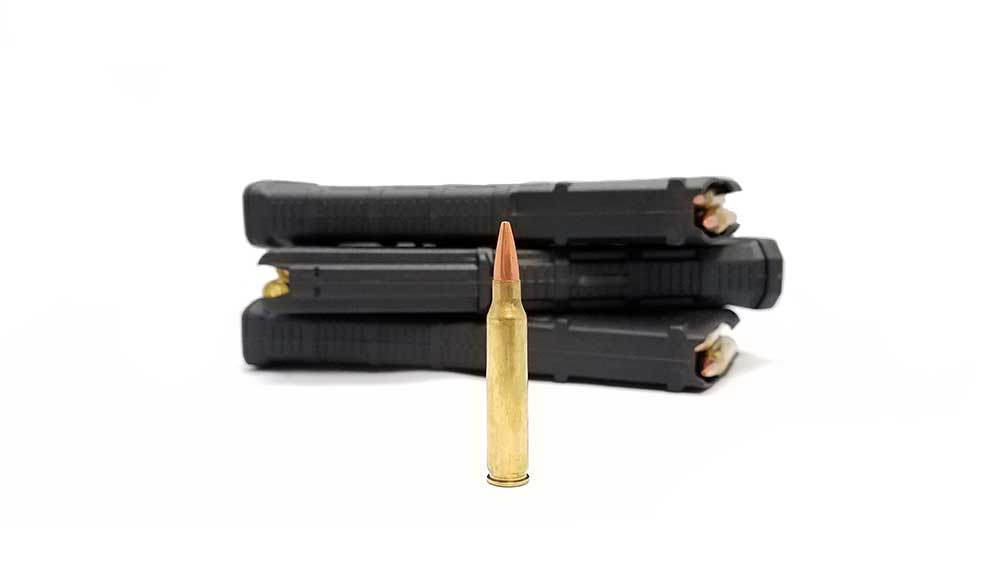
When it comes to choosing 5.56 NATO ammo for home defense and general all-around use, I would love to say that ammo brand “X” can hit the bullseye at silly distances, drop a monster buck on the spot, knock over a distant popper, tumble a quartering coyote and stop an attacker with one well-placed shot every time. Unfortunately, variables such as distance, inherent accuracy, bullet design, barrel twist, shooter skill, stress, fear, sweat, eyesight, darkness, cold fingers and a whole bunch of other stuff gets in the way of one bullet for all needs. Many loads are capable of meeting general-purpose roles, but once we start drilling down to mastering specific tasks—like performing home defense duty—things start to get complicated.
The exact circumstances for when a rifle or carbine comes into play in the home are going to be different for each of us. Since the proliferation of semi-automatic sporting rifles is both far and wide across our country, and since many of those rifles happen to be chambered in 5.56 NATO / .223 Rem., it is worth taking a look at ammunition in this chambering that is well-suited for use inside the home.
But before selecting 5.56 NATO ammo, you have to consider your unique environment. A house full of family members requires different planning than an empty-nester pad. Rural dwellers have more flexibility than those who share common walls with neighbors. Residential interior construction is not well-suited to stop bullets. We have to assume that any shot that misses or passes through its intended target with little upset can harm someone or something we want to protect. This is a good time to point out that proper shot placement is as critical here as it is for any distant shooting pursuit. The fact is that even well-placed shots can penetrate through the human body in spite of our best efforts to prevent it.
Over-Penetration and Frangible 5.56 NATO Ammunition
Blanket concerns about rifle bullet over-penetration date back to the days of heavy, slow-moving, solid-lead and FMJ bullets. Many modern rifle-bullet designs actually perform well at the close ranges commonly encountered in the home. The key is to use the right projectiles for the task. Where over-penetration is a concern, we want 5.56 NATO bullets that quickly fragment into a small number of large pieces or expand enough to stop before exiting the other side.
In addition to reducing the risk of harming family members elsewhere in the house, these bullets usually damage more soft tissue and organs than their non-expanding or non-fragmenting counterparts, leading to faster incapacitations.
Frangible projectiles that are designed to fracture into small pieces once they encounter resistance inside a target limit penetration well. However, the wound channels they create tend to be short and often less damaging than needed. They are tailor-made for environments where a high incidence of ricochet is present—such as around machinery or inside bare concrete, brick or metal structures. The frangible 5.56 NATO loads of 20 years ago were notorious for coming apart in mid-air. Firing them through suppressors was not even an option.
Today’s frangible-ammo options are much better and tend to stay together until they make impact. Unfortunately, I know a couple guys that learned the hard way how even frangible ammunition can penetrate thin, interior walls and hurt good people on the other side. Like any other new ammunition you try, you should ensure frangible ammunition functions correctly in your rifle and that projectiles go where you aim them before relying on them for defense purposes.
5.56 NATO / .223 Rem. Hunting Ammunition: A Good Home-Defense Option?
Modern hunting bullets designed to expand for maximum wound channels in medium-size game seem like an obvious choice for defensive use. However, typical hunting-bullet designs also continue to penetrate after opening up in order to do as much damage as possible after going through thick hides and glancing off or breaking bones. Exit wounds can be beneficial to hunters tracking wounded animals but pose a problem for home dwellers, so what works in the field may not be the best choice in the residence.
Thinly jacketed varmint bullets are at the other end of the spectrum. They tend to come apart easily in tissue—often violently—making them less likely to go through-and-through. In large mammals, though, these projectiles have less-than-desirable wounding characteristics. Soft-point ammunition often works under the right circumstances, but it tends to penetrate fairly deeply in spite of having exposed lead at the nose. Soft points are also more finicky when fed over AR-15 feed ramps.
"Blind-to-Barrier" and Bulk 5.56 NATO Ammo Drawbacks
So-called “Blind-To-Barrier” projectiles are designed specifically to go through sheetrock, plywood, heavy clothing, thin sheet metal and even windshields while still retaining the ability to penetrate soft tissue and cause damage on the other side. They have their place in tactical circles but may not be as well-suited for use indoors where other family members or neighbors may be at risk.
Full-metal-jacket (FMJ) projectiles, typically found in bulk plinking ammo, are definitely not the preferred route for indoor use. An exception would be when nothing better is available and there is no chance of hitting someone else on the other side of your intended target. Another time FMJ could work well is when a bullet that is designed to fracture when yawing is combined with a loose rifling twist that stabilizes the projectile just enough to reach its intended target. Such bullets yaw, tumble and cause significant wounds when paired with the correct rifle barrel.
Velocity and Bullet Stability in Home-Defense Ammunition
Keep in mind that velocity and stability are key to making expanding bullets do what they are designed to do. Expanding projectiles need to hit in a generally head-on attitude in order to fill their voids with soft tissue to the point of forcing expansion. Ensuring the length of a bullet—normally viewed as a component of its weight—is matched to the correct barrel twist will keep it moving point first and gyroscopically stable. You can see this well enough by testing bullet weights and designs in your firearm at realistic distances against cardboard or paper targets. If you do not see round or mostly round holes, you need to change bullet weights until you get good stability at the distance(s) needed.
We are fortunate that modern bullet technology has widened the range of acceptable velocities for optimal performance significantly. But the movement toward ever-shortening barrels means we have to pay more attention to velocity than with the longer barrels more common in days’ past. Normally I take manufacturer-provided ballistic test data with a large grain of salt, but this is one place where it can be helpful.
If an ammo or bullet maker has data available on how their projectiles perform in 10-percent ordnance gelatin, pay attention to the muzzle and impact velocities and the barrel lengths used for obtaining that data. Oftentimes barrels ranging in length from 20 to 26 inches are used to obtain impressive results. Just because a projectile will expand at a specific muzzle velocity from a long barrel does not mean the same will be true from a barrel half that length.
The Benefits of Low-Flash Propellants and SBRs
Bullet performance is not the only indoor concern. Muzzle flash is a huge problem during the hours of darkness. Not only does it make your location clear to anyone not dispatched by the flash’s source, it tends to temporarily make things difficult for your own eyes. In a life-or-death situation, you need to be focused on assessing threats, not a huge bright spot imprinted on your retinas. I build guns for other people for a living. Most of those gun owners intend to use their arms for self-defense shooting, among other pursuits.
The heavily increased demand for short-barrel rifles (SBRs) and rifle-caliber, semi-auto pistols tells me this is a trend that is not going away. Short barrels are notorious for belching bright balls of flame, or secondary muzzle flash, as hot gasses and unburnt powder crash into the atmosphere outside a gun’s muzzle. Thankfully, today we can all benefit from low-flash propellant technology that was once reserved for specialized military and law-enforcement elements.
Combating Concussion in 5.56 NATO Ammo for Home Defense
The concussion that is produced by firing full-power 5.56 NATO ammunition in tight confines can be deafening and disorienting to unprotected ears. Unless you sleep with ear protection in place, there is a fair chance you are going to have to deal with immediate threats with ears wide open. I recommend trying to reduce the blast you have to deal with indoors. Conventional muzzle-brake equipped rifles or carbines amplify the problem through side ports and baffles. Directional muzzle brakes help to a small degree by pushing everything out to the front. But a good, prong-style flash hider is better in this environment. Sound suppressors deal with both muzzle blast and flash and although they add length in most common rifle configurations, are great tools for indoor use. I used a sound suppressor for CQB operations whenever possible while in the Army and was always very happy to have them indoors and out.
Now that we’ve considered the variables in play when choosing home-defense ammo for an AR-15, we’ll examine more specific ammo options in a later article.




































